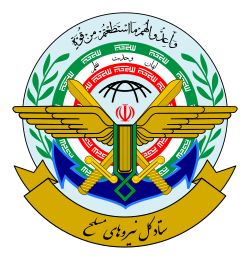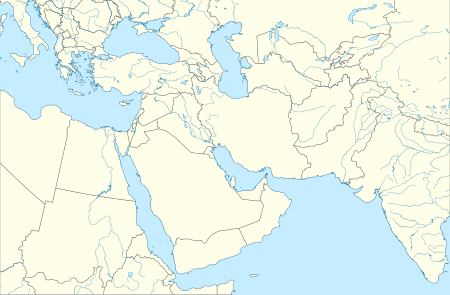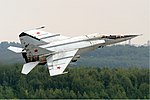Armed Forces of Iran
|
|||
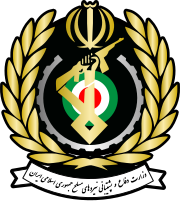
|
|||
| guide | |||
|---|---|---|---|
| Commander in Chief : | Ayatollah Ali Khamenei | ||
| Defense Minister: | Hosein Dehqan | ||
| Military Commander: | General Ataollah Salehi | ||
| Military leadership: | Headquarters of the armed forces | ||
| Headquarters: | Tehran | ||
| Military strength | |||
| Active soldiers: | 610,000 (2019) | ||
| Reservists: | 450,000 active (2019) 500,000–1 million inactive (2019) |
||
| Conscription: | Yes | ||
| Eligibility for military service: | 18 years | ||
| household | |||
| Military budget: | € 6.3 billion | ||
| Share of expenses from tax revenue: | 3.5% | ||
| Share of gross domestic product : | 2.5% (2006) | ||
| history | |||
The armed forces of Iran consist of the regular army, the Artesch , and the paramilitary revolutionary guards (the Pasdaran or Sepah ).
overview
The Iranian military has been affected by the export bans of military material by various states, which have existed in varying degrees since 1979, as well as the losses of large arms in the First Gulf War that continue to have an impact today . This applies in particular to the air force and navy weapon systems. In the case of ground-based weapons systems, the losses are at least offset in numbers. However, many weapons are considered obsolete and in poor technical condition. According to US estimates, the strength of the crew has fallen from 545,000 soldiers in 2008 to 523,000 in 2018, plus around 250,000 reservists.
A large part of the weapon systems in existence today originate from US weapons aid in the period from 1945 to 1979 and, more recently, from arms deals with Russia and the People's Republic of China . For 2017, the IISS puts the Iranian military budget at 16 billion US dollars or 3.75% of gross domestic product (GDP), IHS Janes with 16.2 billion US dollars and 3.85% of GDP and that Sipri with $ 15.5 billion. The United States Department of State cites US $ 11.6 billion and 3% of GDP for 2015.
assignment
Alignment
The task of the armed forces of Iran is to guarantee and defend the territorial integrity of the state of Iran. In addition to traditional national defense, the Basij-e Mostaz'afin and the Iranian Revolutionary Guard also play a domestic political role, securing the form and government of the state and the spiritual leadership elite.
Strategy and operational doctrine
Ideological orientation
The Islamic Revolution of 1979 marked a turning point in the ideological orientation of the Iranian armed forces. According to its theocratic form of government, Iran sees itself as the only country in which a religious and state polity oriented towards Islam has been and is fully realized. In its self-perception, Iran is in contrast - if not in opposition - to all other countries in the world that are either non-Islamic or, according to Iran, do not allow Islam to play an appropriate and decisive role in their political and social structure. One of the tasks of the armed forces is to defend Iran's special form of government. In the years immediately after the Islamic Revolution, the export of the revolution played an important role , especially for the Pasdaran and the Iranian-backed paramilitary forces in the region. In the meantime, however, this approach has largely been supplanted by Realpolitik .
A constant of Iranian foreign policy remains the hostility to Israel , the destruction of which has been propagated with fluctuating emphasis since the Islamic Revolution, but nonetheless constantly. Official Iranian policy regards Israel as an illegally established “Zionist regime”.
Geopolitical orientation
Airfields or air force bases owned or made available to the US Air Force |
At the geopolitical level, Iraq was the only remaining potential opponent of Iran after the collapse of the Soviet Union , to whom most of the defense simulation games were based. After the Third Gulf War , this enemy image largely disappeared. It was replaced by the US military presence in Iraq and Afghanistan , which Iran sees as a threat. Furthermore, Iran sees itself encircled by US air force bases in neighboring Iranian states. In the event of a possible attack by the USA, Iran would not have air sovereignty in Iran due to the poor equipment of the Iranian air force.
In this context, the old approach to defending Islam is given a new meaning. The USA is perceived as an opponent of the Islamic world as a whole. The Iranian image of Israel is shaped in a similar way. Both states are accused of wanting to establish foreign rule over the Islamic world. Iran sees itself as the defender and liberator of the Islamic community of states, if necessary with military means.
The Persian Gulf is of central geopolitical importance for Iran . In addition to the classic strategic problems caused by the long coastline of Iran, the Persian Gulf is the most important waterway for the oil transport for the oil -dependent state . Possible control over him is one of Iran's most important strategic goals.
In the past few years, the civil and proxy wars in Syria and Yemen have become important platforms for Iran's military influence, both through the support of warring parties and through the deployment of Iranian troops.
Operational focus
In the war against Iraq, Iran relied primarily on the quantitative superiority and high motivation through the religious zeal of its poorly equipped troops. Probably mainly as a consequence of the catastrophic own losses as a result of this approach, greater importance has been attached to better technical equipment and more intensive training of the troops since the late 1980s. This change is expressed above all in the development of the Iranian Revolutionary Guard from a poorly structured, revolutionary enthusiastic militia to a traditional military organization with above-average quality armament. The element of a mass army seems to remain in the Basij in the long run, while the army and the Revolutionary Guard at least claim to become modern, high-tech troops. However, the trade sanctions against Iran by many countries make it difficult to realize this claim.
The possibilities for projecting military power over long distances remain limited due to a lack of air and sea transport capabilities, so that Iran is limited to operations within its own borders and in the area near the border. Possible operations in the Persian Gulf play a special role. For direct projection of military strength over long distances, Iran only has its missile arsenal , the al-Quds unit of the Pasdaran , which is geared towards extraterritorial missions, and other extraterritorial troops deployed in the Syrian civil war. Due to the material inferiority compared to other actors in the region, its potential for asymmetrical warfare has increased since the early 2000s , in particular by supporting irregular fighters, for example in Palestine , Syria and Yemen. The military or militant groups supported by Iran financially, with equipment, information and advice include the armed forces of Syria , the Lebanese Hezbollah (according to US estimates with around 700 million US dollars per year), the Palestinian Hamas , Islamic Jihad in Palestine , the Taliban in Afghanistan, Kata'ib Hizballah and other Shiite groups in Iraq, the Bahraini Al-Ashtar Brigades and the Yemeni Houthi . The US government assumes that Iran has trained and supplied weapons on a large scale against US troops and units of the Iraqi government stationed there.
The few known Iranian sources suggest that these two possibilities, together with guerrilla tactics in their own country, should play a decisive role in the event of a US attack . According to this, Iran would react with an expansion of the combat area, which would mean rocket attacks, possibly with B and C weapons, on US and Israeli targets, as well as an activation of irregular and terrorist allies, especially in the Middle East.
Ranks and insignia
The rank structures of the army and the Revolutionary Guard largely correspond to the classical European hierarchy. The badges of rank are also very similar to Western models, using ornaments from Islamic art .
Organization and equipment
guide
The military command rests with the Führer (or leader of the revolution). He has the authority to declare war and peace and to appoint or dismiss the chief of staff , currently Atallah Salehi , and the commanders of the armed forces .
The highest security policy body is the National Security Council . This council works out the security policy and military strategy within the framework of the guidelines of the revolutionary leader, but also deals with all other policy areas that are directly or indirectly related to defense and internal security . The leader of the revolution is also the competent supervisory body of the National Security Council.
The Iranian Ministry of Intelligence and Security is responsible for the regular armed forces and, since a fundamental reform in 1989, also for the Pasdaran . His area of responsibility is limited to the administration of the armed forces. It has 15,000 civilian employees. Strategic decisions lie with the National Security Council , operational decisions are made by the chief of staff and the subordinate military commanders.
The general staff consists of the commanders of the armed forces as well as the pasdaran, the national police and the gendarmerie . The body is based on the model of the general staffs in NATO countries, but also has a political and ideological department .
Iranian Revolutionary Guard
The Pasdaran or Revolutionary Garden ( Persian سپاه پاسداران انقلاب اسلامی - Sepah Pasdaran Enghaleb Islam-e ) was founded by Ruhollah Khomeini on May 5, 1979 in order to combine a large number of paramilitary groups into a force loyal to the government. Initially, they were mainly used in the country to enforce the new system. They should be a counterweight to the regular military, loyal to the revolution. In the meantime, the Pasdaran have developed into a military association with the three classic armed forces and a traditional military command structure. In addition, the Revolutionary Guards perform secret service tasks inside and outside Iran and have considerable political influence.
The troop strength of the Pasdaran is estimated by the US military at 150,000 men, including conscripts. Probably have the Garden 21 infantry - and three pioneer - divisions and 15 independent infantry brigades , 21 air defense brigades, 42 armored, artillery - and ABC -Abwehrbrigaden as well as several special task forces. The size of the “divisions” is more like battalions . The Revolutionary Guards have been led by Major General Mohammad Ali Jafari since September 1, 2007 .
Its naval branch, which comprises around 20,000 men, is mainly equipped with small, agile boats, some of which are armed only with machine guns and bazookas carried by the crew, which enable “ guerrilla tactics” in the Persian Gulf. This division also includes the entire Iranian marine infantry of around 5,000 men. Their ship arsenal comprises around 40 light patrol boats and, since 2002, ten Chinese Houdong- class rocket boats with around 800 C-801 rockets . In addition, it is estimated that the Pasdaran operate five to seven anti-tank missile launchers on the Gulf Coast. Allegedly these are partly equipped with improved versions of the C-802, which operate under the name Noor (light). Ukraine also delivered eight SS-N-22 Sunburn anti-ship missiles to Iran in the early 1990s . In 2002, the acquisition of Chinese high-speed rocket catamarans also began .
In 2003 the Pasdaran Air Force acquired around ten Su-25 Frogfoots, some of them from the evacuated or captured holdings of the Iraqi Air Force (see below), some from unknown sources. In addition, there are about ten ground attack aircraft of the type Embraer Super Tucano / ALX , up to 45 Pilatus PC-7 -Ausbildungsflugzeuge and 20 helicopter of the type Mi-17 in their arsenal. As transport aircraft are 20 Yunshuji-12 and Dassault Falcon 20 and 15 Ilyushin Il-76 from Iraqi stocks and twelve Antonov An-74 is available. The Iranian missiles of the type Shahab 3 are also subordinate to the Pasdaran.
It is considered certain that the association was repeatedly used against armed opposition movements within Iran. The association supported and supports various underground movements in other states in the Gulf region. The most important tool in these covert operations and classic intelligence service profiles is the so-called Al-Quds unit , named after the Arabic name for Jerusalem . This force is believed to be around 5000 strong and divided into different units, each of which is assigned to a region of the Middle East and North Africa. It can be assumed that Quds unit liaison officers are stationed in many Iranian embassies. A training facility may be located on the campus of Imam Ali University in Tehran, and others in secret locations in Iran, Lebanon and Sudan. At the beginning of 2007 the Iranian National Security Council announced that the strength of the Quds unit would be increased to 15,000 men.
In addition, the paramilitary units, the Basitsch , have been subordinate to the Pasdaran since 1980. Its size was given in 1985 with three million members. More recent estimates assume 400,000 members, of which around 90,000 are in active service and 300,000 with reserve status. Probably a troop strength of around one million men can be achieved with a longer mobilization period. The Basitsch are said to be divided into around 740 regional battalions. The Ashura units set up within the Basitsch since 1993 are specifically geared towards the suppression of unrest and uprisings in the country. They should include around 17,000 men and women.
Allegedly, the Revolutionary Guards have also recently set up units with female members. US sources claim to have found out that Pasdaran and Basitsch units have increasingly trained guerrilla and stay-behind operations since the Third Gulf War .
The Pasdaran represent a significant power factor in Iran politically. For example, 13 of the 21 ministers in the cabinet of President Mahmūd Ahmadī-Nežād (the sixth President of the Islamic Republic of Iran) were former commanders of the Revolutionary Guard, including the Ministry of Intelligence. He himself achieved the rank of commander. Numerous high officers are related to members of the high Islamic clergy. In addition, the Pasdaran control numerous companies of considerable economic importance.
Paramilitary police units
An estimated 45,000 to 60,000 men are subordinate to the Iranian Interior Ministry in police and border protection units, which can also take on paramilitary tasks. They have light off-road vehicles , patrol aircraft and around 90 coastal and 40 harbor protection boats . US estimates assume 40,000 members of paramilitary units for 2017.
army
The army is estimated by US military experts at 350,000 men, 220,000 of them conscripts (as of 2018). It has three headquarters in Tehran , Isfahan and Shiraz . The structure is not entirely clear, but probably includes four corps , which in turn consist of four armored and four infantry divisions (of which the 28th and 84th can also be considered mechanized), four independent infantry brigades, and three independent armored brigades , seven artillery regiments, two command divisions, four special forces brigades and one airborne brigade. In addition, there are several not precisely assigned units of brigade strength. The 23rd Special Forces Division is probably the army's most powerful unit. It is divided into four brigades and comprises an estimated 5000 soldiers, among whom there are no conscripts. Only one armored division, the 92nd, corresponds to modern notions of such a unit. Overall, the Iranian army units are organized very inconsistently. There are brigades whose size and equipment are actually more like divisions, units with considerable understaffing, as well as considerable differences between the sizes of units of nominally equal rank. The special forces are also summarized under the term Takavaran .
According to US estimates, Iran, Booth 2018, about 1,513 has battle tanks , 725 armored personnel carriers , 640 armored personnel carriers , 2,030 pieces drawn artillery , 292 self-propelled guns and 1,476 multiple rocket launcher .
| image | model | Type | Country of origin | number | Acquisition date (year) | Remarks |
|---|---|---|---|---|---|---|
| Cobra BMT-2 | Armored personnel carriers |
|
1997 | |||
 |
Boragh | Armored personnel carriers |
|
140 | 1997 | |
| Rakhsh | Armored personnel carriers |
|
||||
| Sarir | Armored personnel carriers |
|
||||
 |
Sayyad | Armored personnel carriers |
|
|||
 |
M113 | Armored personnel carriers |
|
200 | ||
| Hoveizeh | Armored personnel carriers |
|
||||
 |
BTR-50 | Armored personnel carriers |
|
150 | 1966 | |
 |
BTR-60 | Armored personnel carriers |
|
150 | 1966 | |
| Heidar-5 | Mine-laying tanks |
|
2017-2019 | |||
 |
Heidar-6 | Armored personnel carriers |
|
2017-2019 | ||
 |
Heidar-7 | Armored personnel carriers |
|
2017-2019 | ||
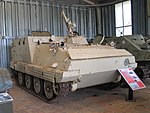 |
YW 531 | Armored personnel carriers |
|
|||
 |
Toofan | MRAP |
|
2018-2019 | ||
 |
Raad | MRAP |
|
2019 | ||
| Rouintan | Armored off-road vehicle |
|
2019 | |||
 |
Type 86 BMP-1 |
amphibious armored personnel carrier |
|
210 | ||
 |
BMP-2 | amphibious armored personnel carrier |
|
400 | 1991-2001 | |
 |
FV101 Scorpion Tosan |
light reconnaissance tank |
|
80+ | 1997 | In-house production Tosan based on the Scorpion included. |
 |
EE-9 Cascavel | light armored car |
|
35 | ||
 |
Zulfiqar MBT 3 Zulfiqar MBT 2 Zulfiqar MBT 1 |
Main battle tank |
|
4 (prototypes) - not clear |
1996-2019 | Zulfiqar is the first Iranian battle tank named after the sword of the prophet Mohammed. |
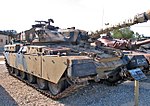 |
Chieftain Mobarez |
Main battle tank |
|
~ 100 | 2006-2019 | Upgraded Chieftain main battle tanks. |
|
M47M Patton Sabalan Tiam |
Main battle tank |
|
~ 170 | 1960s-1970s 2014 2016-2019 |
Upgraded version of the M47M. | |
 |
Samsam | Main battle tank |
|
~ 150 | Upgraded version of the M60A1 . | |
 |
T-62 Ch'ŏnma-ho |
Main battle tank |
|
75 | 1981-1985 | 200 appointed in 1981, 75 currently in service. |
 |
T-72S / T-72M1 | Main battle tank |
|
480 | 1994-1999 | Iran produced 422 T-72S under Russian license from 1993 to 2001, another 104 T-72M1s were procured from Poland in 1994–1995 and 37 T-72M1s from Belarus in 2000. |
 |
Karrar | Main battle tank |
|
800 (planned) | 2017-2019 | In-house production based on the T-72, but significantly improved in combat value. |
 |
T-54 / T-55 Type 59 / Type-69-II Safir-74 |
Main battle tank |
|
540 | The T-54/55 tanks are currently being upgraded to the Safir-74 upgrade. |
| image | model | Type | Country of origin | number | Acquisition date (year) | Remarks |
|---|---|---|---|---|---|---|
 |
Safir | Off-road vehicle |
|
2008-2019 | ||
 |
No ava | Trucks |
|
2012-2019 | ||
| Zafar | Trucks |
|
||||
| Zoljanah | Trucks |
|
||||
| KIAN 700 | Heavy-duty transporter |
|
2019 |
| image | model | Type | Country of origin | caliber | Acquisition date (year) | Remarks |
|---|---|---|---|---|---|---|
 |
PC-9 ZOAF | gun |
|
9 × 19 mm | ||
 |
MPT-9 | Submachine gun |
|
9 × 19 mm | ||
 |
Star Z-84 | Submachine gun |
|
9 × 19 mm | ||
 |
Uzi | Submachine gun |
|
9 × 19 mm | ||
 |
AKS-74U | Carabiner |
|
5.45 x 39 mm | ||
 |
G3A6 | Assault rifle |
|
7.62 × 51 mm NATO | Standard weapon of the Iranian Army (Artesch). | |
 |
AKM Type 56 KL-7.62 |
Assault rifle |
|
7.62 × 39 mm | Mainly used by the Iranian Revolutionary Guards (Pasdaran) and the Basij . | |
 |
AK-103 KL-103 / AK-133 |
Assault rifle |
|
7.62 × 39 mm | Widespread among the Iranian Revolutionary Guards (Pasdaran). However, it is also in action with the 65th Parachute Brigade (NOHED) of the Iranian Army (Artesch) and with the Fatehin units of the Basij . | |
| CQ 5.56 Sayyad 5.56 |
Assault rifle |
|
5.56 × 45 mm NATO | Used by the Saberin units of the Iranian Revolutionary Guard (Pasdaran), among others . | ||
 |
Masaf | Assault rifle |
|
5.56 × 45 mm NATO | Used by the 65th Parachute Brigade (NOHED) of the Iranian Army (Artesch). | |
 |
MG3A3 | Machine gun |
|
7.62 × 51 mm NATO | ||
| PKM-T80 | Machine gun |
|
7.62 × 54 mm rows | |||
 |
Dragunov Nakhjir Hoshar / Hoshdar-M |
Designated Marksman Rifle |
|
7.62 × 54 mm rows | ||
 |
Taher | Sniper rifle |
|
7.62 × 51 mm NATO | ||
 |
Steyr HS .50 AM-50 Sayyad |
Anti-Materiel Rifle |
|
12.7 × 99 mm NATO | ||
| Schaher | Anti-Materiel Rifle |
|
14.5 x 114 mm |
| image | model | Type | Country of origin | caliber | Acquisition date (year) | Remarks |
|---|---|---|---|---|---|---|
 |
RPG-7 | Recoilless anti-tank hand weapon |
|
40 mm (tube) | ||
 |
RPG-29 | Recoilless anti-tank hand weapon |
|
105 mm (tube) | ||
 |
Saegheh | Anti-tank guided missile |
|
|||
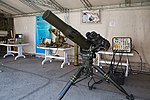 |
Toophan | Anti-tank guided missile |
|
1987-2019 | ||
 |
9K11 Malyutka Raad |
Anti-tank guided missile |
|
|||
 |
9K111 bassoon | Anti-tank guided missile |
|
|||
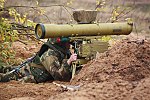 |
9M113 bankruptcy Towsan-1 |
Anti-tank guided missile |
|
|||
 |
9K115-2 Metis-M | Anti-tank guided missile |
|
|||
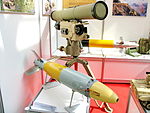 |
Dehlavie | Anti-tank guided missile |
|
Due to the strict secrecy policy of the Iranian military, these figures can be considered imprecise at best.
Among the almost 2,100 non-self-propelled guns make almost 1000 130-mm guns of the type M-46 and about 540 122 mm howitzers of type D30 the main part of. The approximately 310 self-propelled guns are mainly of the type M109 (130 to 150 pieces) and 2S1 (60 to 80). The self-built Raad-1 and Raad-2 self-propelled howitzers are based on Soviet and US models and have probably been delivered to the armed forces since the late 1990s and early 2000s. There are also around 5000 mortars of various calibres. The rocket artillery uses around 700 12-tube launchers of the Chinese type 63 (107 millimeters) as well as around 170 other types of rocket launchers, including several different self-made models with presumably very small numbers. They reach ranges of up to 105 kilometers, although target acquisition systems may not exist that work on this scale. Some of the models can probably also carry chemically or biologically armed warheads. Again, European estimates assume significantly lower numbers of only around 60 multiple projectors. Iran has by far the largest arsenal of artillery in the region.
US observers have not noted any new acquisition or entry into service of self-produced battle tanks since 2000. The Mobarez, Safir-74s and Zulfiqar systems (different versions), which were produced in-house or were upgraded in-house, evidently never went into series production.
The standard assault rifle of the Iranian army is the HK G3 , which is produced under license in Iran by the Defense Industries Organization . In addition to the G3, the S.5'56, a license production made in Iran by the Chinese Norinco CQ , which is a copy of the US M16A1 from Colt , as well as a license production of the Chinese Type 56 made in Iran called KL-7.62 , are used . Weapons specialists such as machine guns and snipers have several weapon options, depending on the type of mission and the range of fire. These include the MG3 , PKM-T80 , MDG and RPK machine guns , all of which are license productions from Iran, as well as the Nakhjir sniper rifle, a license production of the Dragunov sniper rifle made in Iran .
US sources estimate the potential of anti-tank missiles at 50 to 75 TOW and 20 to 30 M47 Dragon launchers and 100 to 200 9K111 Fagots . A copy of the 9M14 Malyutka is made by the country itself. In addition, there are a large number of different smaller anti-tank weapons from the RPG family, as well as various recoilless weapons from Western and Soviet production. The most modern anti-tank missiles are likely to be an unknown number of 9K115-2 Metis-M .
The Army Aviation Department is relatively small and has a little over 100 transport helicopters and around 50 Bell AH-1s in the naval war version in their arsenal. In addition, the army has around 1,700 anti-aircraft guns, mostly of older design. The 50 to 100 radar-guided anti-aircraft guns of the type ZSU-23-4 are likely to be the most modern weapons in this category. In terms of portable anti-aircraft weapons, there are a large number of Strela-2 MANPADS, imported Strela-3 and Igla-1 , whose partly improved copies are manufactured by the country under the names Misagh-1 and Misagh-2 . Various semi-militarized commercial trucks as well as in-house developments such as the Neinava are available as tactical trucks .
Like the other branches of the armed forces, the Iranian army has significant deficits in target reconnaissance and detection, in the maintenance of the equipment and in general with supplies. Soldiers' personal equipment, training and technical communication skills seem to be continuously improving.
marine
The Navy is comparatively small, its strength is an estimated 18,000 men (according to other sources 16,000), of which 2,600 marines in two brigades and 2,000 naval aviators . Most of the remaining marines are infantry on islands in the Persian Gulf. Since 2001, the navy has been at the center of the modernization of the Iranian army and has been equipped with new vehicles. According to the US Office of Naval Intelligence, these advances "demonstrate Iran's ability to manufacture medium-sized to large ships." Since the late 1970s, a large base has been built in Bandar Beheschti , which is to become the heart of the Iranian naval forces. The large surface units are currently stationed in Bandar Abbas , the most important naval base and location of the naval shipyards . The strategic goal of the Iranian Navy is to control the Persian Gulf with its important transport routes (especially for oil tankers ). Accordingly, the navy is geostrategically divided into five operational zones, three of which are in the Persian Gulf. Headquarters:
- Bandar Abbas , Buschehr and Charg
- Bandar Anzali on the Caspian Sea
- Tschahbahar in the Indian Ocean
Surface fleet
According to US estimates (as of 2018), the Iranian Navy has seven corvettes (five of which are conversions and replicas of the British Vosper class and two of the US type PF-103), 18 supply and support units, 15 medium-sized and 13 small landing craft . There are also around 160 patrol boats , 60 of which are equipped with missiles. The boat fleet includes 13 Tiger class units . The larger surface units are largely out of date and come from former British and American stocks.
The medium-sized DropShips can carry up to 350 men and 30 armored vehicles. There are also 13 helicopters (10 Sikorsky S-61 in the SH-3D variant and 3 Sikorsky CH-53 in the RH-53D variant) and 5 Lockheed P-3 anti-submarine aircraft, as well as a transport helicopter battalion and 5 patrol aircraft, their Operability is unclear.
On February 19, 2010, the official commissioning of the first ship of the Moudsch class , the Jamaran , took place. The frigate with a displacement of 1420 tons has a crew of 120 to 140 men, is equipped with electronic warfare equipment and a helicopter landing pad. Their armament consists of ship-to-ship and ship-to-air missiles, torpedoes and an on-board cannon. The Jamaran reaches a top speed of 30 knots. On December 1, 2018, after the Jamaran and Damavand , the Sahand, the third frigate of the Moudsch class, was put into service.
According to unconfirmed reports, Iran has the capacity to produce comparatively modern sea mines and has around 4,000 of these weapons.
Recent developments indicate close cooperation with the People's Republic of China in the development of anti-ship missiles. The first products of these joint developments are the Nasr and Kosar , which in the People's Republic of China bear the designation TL-6 and TL-10 . Around 100 anti-ship missiles of the Chinese types CS-801 and CS-802 are already in the Iranian arsenal. However, the range of the Iranian sea target reconnaissance is considerably below the weapon range (C-802: 120 kilometers). According to US estimates, the frigates and around a dozen patrol boats are equipped with CSS-N-4s. Around ten other patrol boats each carry missiles of the types C-802 (CSS-C-8) and C-701, also known as Saccade and Kowar in Iran .
Submarine fleet
The Iranian Navy has 3 diesel-electric submarines of the type Project 877 EKM from Russian production, which were purchased between 1992 and 1997, as well as 18 small submarines.
Small submarines of the so-called Ghadir class with a range of 300 km were shown on Iranian television in 2005 and took part in a major sea maneuver in April 2006. In 2008, Tehran also announced the start of production of a larger and more effective range of submarines, the 1,000-ton Qa'em class.
units
| image | model | Type | Country of origin | displacement | Number (ready to use) | Acquisition date (year) | Remarks |
|---|---|---|---|---|---|---|---|
| Yugo class | Small submarine |
|
90-110 tons | 4th | 2007 | ||
 |
Ghadir class | Small submarine |
|
115-120 tons | 23 | 2007-2018 | |
| Nahang class | Submarine |
|
350-400 t | 1 | 2006 | ||
| Fateh class | Submarine |
|
527-593 tons | 1 | 2013-2015 | Three more Fateh-class submarines are currently under construction. The fourth submarine in this class will be equipped with an external air-independent propulsion system (AIP). | |
| Besat class | Submarine |
|
3000 t | 1 | Will be equipped with a vertical launch system (VLS) for missiles and with a displacement of 3000 tons will be heavier than previously expected. | ||
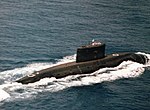 |
Project 877 | Submarine |
|
2300-3076 tons | 3 | 1992-1997 | Tareq , Nooh and Junes |
| image | model | Type | Country of origin | displacement | Number (ready to use) | Acquisition date (year) | Remarks |
|---|---|---|---|---|---|---|---|
| Seraj-1 | Speedboat |
|
12 | ||||
| Peykaap I class | Speedboat |
|
74+ | ||||
| Tir / IPS-18 class | Patrol boat |
|
28.16 t | 10 | |||
| MIG-S-1800 class | Patrol boat |
|
22 t | 20th | |||
| Mk III class | Patrol boat |
|
28-36 t | 10 | |||
| MIG-G-1900 class | Patrol boat |
|
60 t | 6th | |||
| MIG-S-2600 class | Patrol boat |
|
70-82 t | 6th | |||
| Bavar class | Patrol boat |
|
|||||
| Kaivan class | Patrol boat |
|
98-148 tons | 3 | |||
| Parvin class | Patrol boat |
|
98-148 tons | 3 | |||
| Chaho class Zafar class |
Patrol boat |
|
70 t | 3 | |||
| Peykaap-II / IPS-16 class | Missile speedboat |
|
13.75 t | 10 | |||

|
C 14 class Azarakhsh |
Catamaran - missile speedboat |
|
20 t | 9 | ||
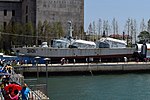 |
Houdong / Tondar class | Missile speedboat |
|
175 t | 10 | 1994-1996 | |
 |
Kaman class | Missile speedboat |
|
234 t | 10 | 1977-2006 | |
 |
Sina class | Missile speedboat |
|
234 t | 4th | 2003-2017 | |
| Hendijan / Kalat class | Missile speedboat |
|
610 t | 8th | |||
| Hamzeh class | corvette |
|
580 t | 1 | 1965 | ||
| Bayandor class | corvette |
|
1135 t | 2 | 1964 | ||
 |
Alvand class | frigate |
|
1100 t | 3 | 1971-1972 | |
 |
Moudsch class | frigate |
|
1300 t | 2 | 2010-2018 | The Moudsch-class ship "Damavand" is currently being repaired after being badly damaged in 2018. Four more ships are currently being built. The ship "Dena", which is still in the manufacturing process, is to be put into service in February 2020. |
| "Safineh" project | Trimaran destroyer |
|
3000 t | The construction of the ship is planned. | |||
| Khalij-e Fars class | destroyer |
|
6500 t | Currently under construction. | |||
| "Negin" project | destroyer |
|
7000 t | The construction of the ship is planned. |
| image | model | Type | Country of origin | Range | Warhead | number | Acquisition date (year) | Remarks |
|---|---|---|---|---|---|---|---|---|
| Kowsar | Anti-ship missile |
|
18 km | 29 kg | 2006-2019 | |||
| Nasr | Anti-ship missile |
|
27-35 km | 130 kg | 2005-2019 | Based on the Chinese C-704. | ||
| Nasir | Anti-ship missile |
|
35+ km | |||||
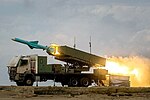 |
Noor | Anti-ship missile |
|
130-200 km | 165 kg | 2000-2019 | Based on the Chinese C-802 . | |
 |
Qader | Anti-ship missile |
|
200 km | 200 kg | 2011-2019 | Improved version of the Noor anti-ship missile. | |
| Ghadir | Anti-ship missile |
|
300 km | 2015-2019 | ||||
| Raad | Anti-ship missile |
|
350 km | 450-500 kg | 2007-2019 | Based on the Chinese Silkworm . |
| image | model | Type | Country of origin | Number (ready to use) | Acquisition date (year) | Remarks |
|---|---|---|---|---|---|---|
| Sejjil | Combat drone |
|
2019 | The drone uses two turbojet engines, can reach a top speed of 1000 km / h and carry glide bombs with a range of 100 km. Sejjil is the first drone of the Iranian Navy and can be launched from ships. | ||
| Simorgh | Combat drone |
|
2019 | |||
| Pelican-2 | Reconnaissance drone |
|
2019 | Pelikan-2 is a vertical takeoff drone. |
air force
The Iranian Air Force ( headquarters : Doschan Tape , near Tehran) has little power because the country could hardly procure ammunition and spare parts for Western planes and weapons that were bought before the Islamic Revolution.
It is believed that the strength of the Iranian Air Force is just over 30,000 men (other sources: 52,000 men), plus around 12,000 in the air defense forces. According to US estimates (as of 2018), Iran has 334 combat aircraft, 50 attack helicopters, 237 launchers for larger anti-aircraft missiles, slightly more than 514 launchers for light anti-aircraft missiles and manpads, and more than 1,122 anti-aircraft guns. The largest number of aircraft are Northrop F-5 (around 75), F-4 Phantom II (around 65) and F-14 Tomcat (80 units were purchased up to 1978, 79 of which around 40 are still in service today) out. The combat units are divided into nine squadrons for combat against ground targets (162 to 186 aircraft), seven fighter squadrons (70 to 74 aircraft) and a reconnaissance squadron (four to eight aircraft). Along with the F-14, Iran also purchased the long-range AIM-54 Phoenix air-to-air missile from the United States.
The air transport fleet consists of a large number of different aircraft (almost 50 pieces) and helicopters (around 60), the latter mainly Mi-17 and Bell 214.
14 airports are currently to be used by the military. Airborne units suitable for the fight against ground targets are permanently stationed in Bandar Abbas, Bushehr , Dezful , Hamadan , Tabriz and in Tehran's Mehrabad Airport . The interceptor squadron and a transport unit have their bases in Shiraz . The most important repair yard for aircraft is in Mehrabad. The three regional headquarters are located in Badl Sar (north), Mashhad (center) and Bushehr (south).
The supply of spare parts for aircraft is being sought through the now relatively independent aviation industry and the illegal procurement of spare parts abroad. With Russian help, some improvements are said to have been made. However, the exact number of machines that can be used remains an unknown quantity. US estimates suggest that around 100 Iranian Air Force jet planes were airworthy in 2000. In addition to the combat aircraft, there are around 15 reconnaissance aircraft with the appropriate electronic equipment, 100 training aircraft and around 35 helicopters, but these are not suitable for direct combat missions.
In 1991 the Iraqi Air Force brought a large part of its aircraft to Iran, which was officially still an opponent of the war at the time, in order to avoid the destruction of the air fleet in the Second Gulf War . These aircraft included 24 Mirage F1 , four Su-20 Fitter , 40 Su-22 Fitter , 24 Su-24 Fencer , seven Su-25 Frogfoot , nine MiG-23 Flogger, and four MiG-29 Fulcrum. It remains unclear which aircraft of these were integrated into the service of the Iranian Air Force. To date, none of these aircraft have been returned to Iraq.
So far, Iran had produced a Saeqeh (German: Donner) fighter aircraft itself . Of this, a replica of the Northrop F-5, a maximum of five machines should be operational. According to US estimates, some self-built drone models are already in use.
Anti-aircraft missiles in service include both Western and Soviet / Russian and Chinese systems and their Iranian copies. These include more than 250 launchers for Crotale , more than 150 starters for Hawk , 45 for S-75 , around 30 for Rapier , ten S-200 , an unknown number of HQ-7s in the export variant FM-80 and 29 short-range air defense systems of the Type 9K330 gate . In 2016, various sources reported the beginning of the installation of modified or self-built systems of the type S-300P , of which 32 systems are currently (as of 2018) in use. Many of these air defense systems have been equipped with modified technology. There are around 200 launching devices on manpads, including FIM-92 Stinger , 9K32 Strela-2 (also in the HN-5A variant), Igla-S , 9K34 Strela-3 , replicas of the Chinese QianWei-1 and QianWei-2 under the same name Misagh-1 and Misagh-2 .
The following models of anti-aircraft guns are used: SU-23 (300 guns), Oerlikon 37 mm, ZSU-23-4 (100 vehicles), ZSU-57-2 (80 vehicles), ZPU-2 , ZPU-4 , Skyguard with Oerlikon 35mm twin gun (92 systems), 37mm automatic anti-aircraft gun M1939 (61-K) , 40mm Bofors L / 70 gun (50 guns), S-60 (200 guns) and 85mm Anti-aircraft gun M1939 (52-K) (300 guns).
The Fajr-27 rapid fire cannon has been in production since 2006 . Some S-200 missiles were renamed Fajr-8 and modified, further provides Iran an improved copy of the Soviet S-75 or its Chinese copy of HQ-2 under the name Sayyad-1 and the improved version Sayyad-2 ago .
Production of the Samavat anti-aircraft gun began in 2008, and this is also a modified copy of the Oerlikon 35 mm twin gun . Another anti-aircraft gun was presented in early 2009. According to official information, this is a 100 mm cannon, which is controlled fully automatically by a radar.
There is no uniform fire control system covering larger areas. Rather, air defense is based on smaller, hardly networked defense centers at strategically important points. The range of individual radar systems acquired from China is 300 kilometers. According to the Air Force Commander in Chief, General Ahmad Migani, Iran is currently (2008) developing active and passive radars with a range of 1000 kilometers .
| image | model | Type | Country of origin | Number (ready to use) | Acquisition date (year) | Remarks |
|---|---|---|---|---|---|---|
 |
HESA Ababil-3 | Reconnaissance drone / combat drone |
|
~ 217 | 2008-2019 | The Ababil-3 drone can be equipped with two Qaem-1, Qaem-5 or Qaem-9 glide bombs. |
 |
Qods Mohajer-2 Qods Mohajer-2N |
Reconnaissance drone |
|
1990s-2019 2014-2019 |
||
 |
Qods Mohajer-4 Qods Mohajer-4B |
Reconnaissance drone |
|
1999-2019 2014-2019 |
||
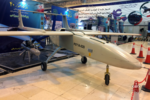 |
Qods Mohajer-6 | Reconnaissance drone / combat drone |
|
~ 30 | 2018-2019 | The Mohajer-6 drone can be equipped with two Qaem-1, Qaem-5 or Qaem-9 glide bombs. |
| HESA Shahed-121 | Reconnaissance drone |
|
Iran apparently used the Shahed 121 drone several times in the past to spy on US aircraft carriers in the Persian Gulf. | |||
| HESA Shahed-123 | Reconnaissance drone / combat drone |
|
The Shahed 123 drone is based on the Israeli Hermes 200, one of which Iran captured in 2014, and can be equipped with two Sadid 345 glide bombs. | |||
 |
HESA Shahed-129 | Reconnaissance drone / combat drone |
|
~ 23-25 + 40 ordered | 2012-2019 | Successor to the Shahed 123 drone, which can be equipped with four Sadid 345 glide bombs. |
 |
HESA Hamaseh | Reconnaissance drone / combat drone |
|
2016-2019 | The Hamaseh drone can be equipped with two Qaem-1, Qaem-5 or Qaem-9 glide bombs. | |
| Farpad | Reconnaissance drone |
|
2016-2019 | The Farpad is a small reconnaissance drone with a maximum flight time of 45 minutes, a range of 20 km and a weight of 4 kg, which can be thrown into the air by one person and thus started. | ||
| Sayeh | Reconnaissance drone |
|
Copy of American ScanEagle . | |||
 |
Qods Yasir | Reconnaissance drone |
|
2013-2019 | Based on the US ScanEagle . | |
 |
Saegheh-1 Saegheh-2 |
Stealth reconnaissance drone / combat drone |
|
2016-2019 | Based on the US RQ-170 , which Iran either shot down in the east of the country in 2011 or brought down using electronic warfare . In contrast to the RQ-170, the Saegheh-2 drone is significantly smaller and has two internal weapon bays in which it can carry two Sadid-345 glide bombs. | |
 |
Shahed-171 Simorgh | Stealth reconnaissance drone / combat drone |
|
1: 1 copy of the US RQ-170 . | ||
 |
HESA Karrar | Combat drone / target display drone |
|
2010-2019 | Used for training purposes as a target for Iranian air defense systems, but can also be used as a long-range attack drone. In terms of armament, the drone can carry a Mark-82 free-fall bomb, one or two Nasr-1 anti-ship missiles, two Kowsar anti-aircraft missiles, two Mark 81 free-fall bombs or a Balaban glide bomb. The additional weapon load would reduce the operational range. | |
| Mobin | Stealth combat drone |
|
10 | 2018-2019 | The Mobin stealth drone was presented at the MAKS 2019 in Moscow and is said to have stealth technology. Its operational range is 450 km, its payload 120 kg and it is steered using TERCOM / DSMAC . | |
 |
Kaman-12 | Combat drone |
|
2019 | The Kaman-12 drone has a maximum flight time of 10 hours, a speed of 200 km / h, an operational radius of 1000 km and can carry a payload of up to 100 kg. It can be equipped with Akhgar airborne cruise missiles that have an operational range of 30 km. |
| image | model | Type | Country of origin | Range | number | Acquisition date (year) | Remarks |
|---|---|---|---|---|---|---|---|
 |
rapier | Short-range anti-aircraft missile system |
|
7 km | 1971 | ||
 |
Ya Zahra-3 Heart-9 |
(Mobile) short-range anti - aircraft missile system |
|
8.6 km | 42+ (9 of hearts) | 2013-2019 2013-2019 |
Based on the Chinese HQ-7 (FM-80) which in turn is imitated the French Crotale . The Herz-9 system is an improved mobile version of the Ya Zahra-3 short-range anti -aircraft missile system . |
 |
Gate-M1E | Mobile short-range anti - aircraft missile system |
|
12 km | 29 vehicles, 4 active locations (as of 2012) | 2007 | |
 |
Panzir-S1 | Mobile short-range anti - aircraft missile system |
|
18 km | 10 vehicles | 2008 | |
 |
2K12E cub Raad-1 |
Mobile short-range anti - aircraft missile system |
|
24 km | 2 active locations (as of 2012) | 1995 2014 |
|
 |
HQ-2 Sayyad-1 Sayyad-1A |
Medium-range anti-aircraft missile system |
|
12-32 km 40-45 km 50-60 km |
23–45 launch devices | ||
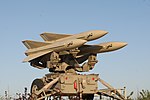 |
MIM-23B Hawk Mersad Ghader Mersad-16 |
Medium-range anti-aircraft missile system |
|
40-45 km | 120 | 1970 2010-2019 2012-2019 2019 |
The Mersad anti-aircraft missile system is a specially produced version of the American Hawk system, improved by Iran. For this purpose, Iran has developed two guided missiles "Shahin" and "Shalamche" with an increased speed of Mach 3. Ghader is a mobile variant of the Mersad system. |
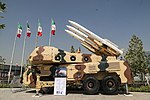 |
Raad-2 Tabas 3. Khordad |
Medium-range anti-aircraft missile system |
|
50 km 50-60 km 50-105 km |
2 locations with 4 systems each (Raad-2) | 2014-2019 | On June 20, 2019, the Iranian armed forces shot down an unmanned US drone of the type "RQ-4A Global Hawk" by the anti-aircraft missile system "3. Khordad". An Iranian Sayyad-2 anti-aircraft missile was used in the shooting down. |
 |
Sayyad Talash-2 Talash-3 |
Medium-range anti-aircraft missile system Medium-range anti-aircraft missile system Long-range anti - aircraft missile system |
|
50 km 35-70 km 150 km |
12 systems at 3 locations (Talash-2) | 2017-2019 | Uses Iranian Sayyad-2 or Sayyad-3 missiles and is to replace the S-200 systems in the future. |

|
15. Khordad | Long-range anti - aircraft missile system |
|
120 km | 2019 | According to Iranian information, the system can destroy stealth targets at a distance of 45 km using Sayyad-3 missiles. | |
 |
S-200WE Fajr-8 Ghareh |
Long-range anti - aircraft missile system |
|
240 km 200-250 km 250 km |
6 locations with 6 starting devices each (S-200) 5 battalions with 6 launch devices each (Ghareh) |
||
 |
S-300PT S-300PMU-2 |
Long-range anti - aircraft missile system |
|
75 km 200 km |
4 batteries 4 batteries |
2008 2011-2016 |
Iran received the S-300PT systems from Belarus in 2008 and the last S-300PMU-2 systems from Russia in 2016. |

|
Bavar-373 | Long-range anti - aircraft missile system |
|
200 km | 4+ | 2019 | The Bavar-373 uses Sayyad-4 long-range missiles to target both airborne targets and ballistic missiles at a distance of 200 km. |
On February 2, 2013, the 34th anniversary of the Islamic Revolution in Iran, President Mahmoud Ahmadinejad unveiled a new fighter jet. The Qaher 313 (Conqueror 313) system "was one of the most modern combat aircraft in the world" and was "designed and built by Iranian engineers," said Ahmadinejad. According to media reports, it corresponds to the American F / A-18, but externally is based on the F-5E / Tiger II . The fitness to fly is questioned.
Missile arsenal
The Iranian missile arsenal is now seen as one of the greatest threats, especially to US forces in the region and to Israel . All systems in this category are subordinate to the Pasdaran. However, information on the extent of Iran's missile armament is vague. The country can manufacture medium-range missiles in-house.
U.S. estimates from 2018 assume the following ballistic missile inventory: 250 Frog-7 missiles , 200 Oghab (45 km range), 250 Shahin-2 (20 km range), 18 BM-25 , 500 Naze ' at 6 and Naze'at 10 (70 and 140 km range), 200 Tondar-69 (based on the S-75 , 150 km range), 250 Shahab-1 , 50 Shahab-2 and 25 Shahab 3 . The number of short- and medium-range missiles of the type Fateh, Qiam, Sejjil, Zolfaghar and Emad as well as the cruise missiles Soumar and Ra'ad is unclear. It is also unclear whether the medium-range missile Ghadr-110 is still under development or ready for use.
In 2001, twelve (not-ready) cruise missiles were of type Ch-55 from the Ukraine bought. These are cruise missiles with a range of up to 3000 kilometers. However, Iran lacks a corresponding carrier system, which calls into question the practical benefits of this acquisition. With the analysis of the propulsion technology and target tracking of these missiles and a cooperation with China, Iran could possibly construct its own missiles with a similar range.
There were several indications from intelligence and Iranian military circles that research is being carried out on multi-stage rockets based on North Korean and Russian technology, including the alleged Shahab-6 project with a range of up to 10,000 kilometers. While these are probably rumors or very early research projects, a first proprietary solid-fuel rocket called the Sajjil-2 appears to be well advanced. With a payload of 750 kilograms, the model flies 2200 kilometers and, according to US estimates, will be ready for military use in 2012.
On October 26, 2005, a Russian rocket launched the first Iranian satellite, the Ukrainian-built Sinah-1 spy satellite , into space. On August 17, 2008, a new launcher was launched for the first time. The Omid ( Messenger of Hope) is a further development of Kavoshgar 1 (Researcher), which was first tested in February 2008.
| image | model | Type | Country of origin | Range | Warhead | number | Acquisition date (year) | Remarks |
|---|---|---|---|---|---|---|---|---|
 |
Hadid HM 20
|
Multiple rocket launchers |
|
21.5 km 30 km 18 km 40 km |
18.3 kg 18.3 kg 18.3 kg 22 kg |
Iranian variant of the Soviet BM-21 . | ||
 |
Falagh-1 | Artillery missile |
|
10 km | 50 kg | 1990s – 2020 | ||
 |
Falagh-2 | Artillery missile |
|
11 km | 60 kg | 1990s – 2020 | ||
 |
Fajr-1 | Multiple rocket launchers / artillery missiles |
|
8.5 km | 6 kg | Iranian variant of the Chinese type 63 . | ||
 |
Fajr-3 | Multiple rocket launchers / artillery missiles |
|
45 km | 45 kg | 1996-2020 | ||
 |
Fajr-5 Fajr-5C |
Multiple rocket launchers / artillery missiles Guided artillery missile |
|
75 km | 90 kg | 2000s – 2020 | ||
 |
Naze'at-6 Naze'at-10 |
Artillery missile |
|
100 km 150 km |
150 kg 250 kg |
500 | 1980s - unclear | |
 |
Zelzal-1 Zelzal-2 Zelzal-3 Zelzal-3B |
Artillery missile / short-range missile |
|
100-125 km 300 km 150-400 km 260 km |
500-600 kg 500-600 kg 900 kg 600 kg |
1990 – unclear | ||
| Labeik-1 | Short-range missile |
|
2019-2020 | The Labeik-1 appears to be a Zelzal missile that was fitted with a retrofit kit and is now precision-guided. | ||||
 |
Tondar-69 | Artillery missile / short-range missile |
|
150-180 km | 190-200 kg | 1992 | Based on the Chinese CSS-8 rocket. | |
 |
Fateh-110 | Short-range missile |
|
300 km | 448 kg | 2002-2020 | ||
| Fateh-313 | Short-range missile |
|
500 km | 500 kg | 2015-2020 | Newer generation of the Fateh-110. | ||

|
Zolfaghar | Short-range missile |
|
700 km | 579 kg | 2016-2020 | ||
| Fateh Mobin | Short-range missile / anti-ship missile |
|
300-500 km | 2018-2020 | ||||
| Raad-500 | Short-range missile |
|
500 km | 2020 | ||||
| Zelzal-e Bareshi | Short-range missile |
|
300 km | 510 kg (30 × 17 kg) | Missile of the Fateh family, which has a warhead with cluster munitions. | |||
 |
Khalidsch-e Fars | Anti-ship missile |
|
300 km | 650 kg | 2014-2020 | Variant of the Fateh-110 for combating sea targets. | |
| Hormuz-1 Hormuz-2 |
Anti-radar missile Anti-ship missile |
|
250 km | 442 kg | 2014-2020 2017-2020 |
Variants of the Fateh-110 for combating radar systems and sea targets. | ||
| Shahab-1 | Short-range missile |
|
300 km | 980 kg | 250–300 (as of 2008) | ~ 1987-2016 | The Shahab-1 missile is the first short-range missile modified by Iran. | |
 |
Shahab-2 | Short-range missile |
|
500 km | 750 kg | 200-450 (as of 2008) | 2004-2016 | |
| Qiam-1 Qiam-2 |
Short-range missile |
|
700 km | 645 kg | 2010-2020 | Based on the Shahab-2 missile. | ||
 |
Shahab 3 Shahab-3A Shahab-3B |
Medium-range missile |
|
1150 km 1300-1700 km 2000 km |
670 kg (Shahab-3) 700 kg (Shahab-3B) |
300 | 2003 – unclear | |
| Dezful | Medium-range missile |
|
~ 1000 km | ~ 450 kg | 2019-2020 | |||
| Fajr-3 | Medium-range missile |
|
2000 km | 2006 | Not to be confused with the Fajr-3 artillery missile of the same name. Little is known about the Fajr-3 missile, but it is said to have multiple warheads ( MIRV ). | |||
 |
Ghadr-1 Ghadr-F Ghadr-H Ghadr-S |
Medium-range missile |
|
1800 km 1950 km 1750 km 1350 km |
650 kg | 2007-2020 | Modified Shahab-3A with improved accuracy. The Ghadr-S missile has cluster munitions . | |
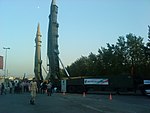 |
Sedjil-1 Sedjil-2 |
Medium-range missile |
|
2000-2500 km | 650 kg | 2014-2020 | ||
| Emad | Medium-range missile |
|
1650-1700 km | 750 kg | 2015-2020 | A further development of the Shahab-3 missile, which has a maneuverable re-entry vehicle ( MaRV ). | ||
 |
Khorramshahr Khorramshahr-2 |
Medium-range missile |
|
2000+ km | 1800 kg 1500 kg |
2017-2020 | Can be equipped with multiple warheads ( MIRV ). | |
| BM-25 Musudan | Medium-range missile |
|
2500-4000 km | 500-1200 kg | 18th | 2005 | According to reports from WikiLeaks , Iran has acquired 18 North Korean BM-25 missiles. |
| image | model | Type | Country of origin | Range | Warhead | number | Acquisition date (year) | Remarks |
|---|---|---|---|---|---|---|---|---|
| Akhgar | Airborne cruise missile |
|
30 km | 7 kg | 2019 | Serves as the main armament of the Kaman-12 drone, among other things. | ||
| Ya Ali | Cruise missiles |
|
700 km | 200 kg | 2014-2019 | |||
| Soumar | Cruise missiles |
|
2000 km | 2015-2019 | Based on the Soviet / Russian Ch-55 . | |||
 |
Hoveyzeh | Cruise missiles |
|
1350 km | 2019 |
ABC weapons
A weapons

The nuclear program of Iran is cause for substantial tension in relations between Iran and the West. There are three research reactors in Tehran, Ramsar and Bonab. With Russian help, a light water reactor was built in Bushehr in the south of the country . There is also a uranium enrichment facility in Natanz and for the production of heavy water at Arak and nuclear fuel rods at Isfahan . Several heavy water reactors are being planned. The latter can be used to produce weapons-grade material. The United States in particular has been accused of the fact that the facilities are used to manufacture nuclear weapons . The Iranian government denies these allegations. Iran also argues that the use of nuclear weapons is incompatible with Islamic teaching and that it is a crime against humanity.
The basis for research into uranium enrichment was laid as early as the Pahlavi era . However, the Shah saw no reason to promote the military use of nuclear energy. With the Islamic Revolution, Khomeini forbade any continuation of the existing research program with the words un-Islamic . It was not until 1984, after the Iraqi chemical weapons use in the First Gulf War , that Khomeini revised his opinion to the effect that a research and development program was established. In 2003, the suspicion of secret uranium enrichment into weapons-grade material led to an IAEA resolution .
Since the Third Gulf War at the latest , the possibility of Iran making atomic bombs has moved into the focus of strategic considerations in the USA and Israel.
B weapons
Iran is said to have been interested in biological warfare agents in the context of the war experience in the first Gulf War . Scientific work on pathogens appears to take place, as Oliver Thränert writes, at Iranian universities. "In this respect, it can be assumed that an Iranian biological weapons program is very closely linked to civil research or research on measures to protect against biological weapons." The US government, on the other hand, assumes an offensive biological weapons program by Iran, which, contrary to the signing of the Biological Weapons Convention of April 10, 1972 , is said to have led to presumably biological warfare agents. However, the quantities available are still unlikely to be sufficient for military use.
Chemical weapons
In response to the massive and successful use of chemical weapons by Iraq in the first Gulf War, Iran tried to set up its own chemical weapons program. With the end of the first Gulf War, according to Iran, the Iranian chemical weapons program was discontinued. In 1998, Iran, as a signatory to the Chemical Weapons Convention, admitted to having developed and produced chemical weapons, but today it does not hold any current chemical weapons stocks. Presumably several thousand tons of phosgene , cyanide gases and small amounts of mustard gas were produced.
“The US government is convinced that Iran not only has several thousand tons of chemical warfare agents, but is intensively continuing its entire chemical weapons program. [...] Even if no chemical warfare agents are currently being produced in Iran, the country would then have a mobilization capacity that would allow it to manufacture larger quantities of chemical warfare agents in a shorter time. "
The Chemical Weapons Convention was signed by Iran under the Akbar Hashemi Rafsanjani government on January 13, 1993 and came into force on December 3, 1997.
Arms industry and arms trade
Since the Shah regime there has been a tradition of a state - controlled arms industry in Iran. After the Islamic Revolution, this industry largely collapsed. In 1981, in view of the war with Iraq, the Defense Industry Organization was created, half of whose governing body consisted of high-ranking officers and civilians. During this phase, primarily infantry ammunition was manufactured, and probably to a lesser extent components for military ground vehicles. In addition, Iran made efforts to build up its own repair capacities for its large weapon systems, since spare parts and specialist knowledge could hardly be obtained from abroad due to the embargo. From 1983 the Pasdaran built an armaments industry that was independent of the regular army, which also mainly produced equipment and ammunition for the infantry.
Since 1990 the Iranian defense industry has concentrated on the construction of airplanes and helicopters as well as on the manufacture of spare parts for aircraft. Today, besides Israel, Iran is the only state in the Gulf region that has sought to develop an independent arms industry on a larger scale. With the exception of rifled artillery, multiple rocket launchers, military boats and ballistic missiles, however, only a few large weapon systems have been produced to any significant extent. In the case of many new developments presented in a publicly effective manner, the real usability and a production potential of more than prototypes are questionable.
The Iranian aviation industry is currently working on several in-house developments based on the F-5. Another project is the Shafagh , which has limited stealth properties and is intended to take on the role of trainer and light attack aircraft in the future. The Shafagh emerged from the Russian LFI project of the Mikojan-Gurewitsch (MiG) company and was known there under the name Projekt Integral / I-2000 . The Shafagh is currently still in an early stage of development. It is currently unclear whether Russia will continue to be involved in the development.
The missile program is also subordinate to the organization of the defense industry, as are several production and research facilities located near the town of Parchin . The largest explosives and ammunition factory in the country is also located there. Various missiles are manufactured there, from light anti-tank missiles of the RAAD type (copy of the 9K11 Malyutka ) to fuel for the Iranian medium-range missiles. Facilities for nuclear research and technology are also stationed near Parchin.
Because of the arms embargo, Iranian arms imports have steadily declined since the 1990s. The Science Service of the US Congress assumes that arms imports worth 2.2 billion US dollars were completed between 2002 and 2005, but most of them are still pending. With a value of 1.7 billion dollars, Russia is clearly at the forefront of Iranian trading partners when it comes to deals. For the period from 2008 to 2011, the science service states agreed arms imports worth around 200 million US dollars and for 2012 to 2015 around 600 million US dollars. Weapons worth 300 million US dollars were delivered from 2008 to 2011 and 100 million US dollars from 2012 to 2015. For the period from 1988 to 2017, Sipri sums up arms imports worth a good 9.3 billion US dollars. Of this, weapons worth almost 3.9 billion euros came from Russia, almost 2.5 billion euros from China and around 1.3 billion euros from the Soviet Union. Spread across weapons systems, imports worth a good 2.1 billion US dollars each were for rockets and armored vehicles, nearly 2.1 billion US dollars for aircraft and 1.5 billion US dollars for watercraft.
Iran itself supplies Syria , the Lebanese Hezbollah , several militant groups in the region and, since 2014, Iraq with weapons. The anti-tank missiles of the type 9K115-2 Metis-M, with which Hezbollah destroyed or damaged several Israeli Merkava- type tanks in the 2006 Lebanon war , came from Iranian stocks. The same applies to the type C-802 anti-ship missile, with which an Israeli corvette was badly damaged.
Recruitment and training
All male Iranians are conscripted. At the age of 19 they have to start their armed service, volunteers can do so at the age of 16. For the Basij-e Mostaz'afin , the minimum age is 15 years. After 18 months of compulsory military service, there is a six-year standby reserve, an eight-year first-order reserve and nine-year second-order reserve. In 2006, around 220,000 active conscripts belonged to the Iranian armed forces, who were used exclusively in the army.
In the meantime, the Iranian government is considering suspending conscription due to the high costs and enormous psychological stress and replacing it with a system on a voluntary basis. Instead of the previous 2 years, recruitment should be enforced for 5 years to make the army more efficient.
There are also programs for military training for women on a voluntary basis. However, the regular army does not accept female fighters. It is not known whether and how women with military training are structured in their own structures. The main training facilities for Iranian officers are the military academy in Tehran , a telecommunications school in Shiraz, and the naval academy in Nouschahr on the Caspian Sea .
history
army
The founding of the Iranian army goes back to Reza Khan , who later became Reza Shah Pahlavi. Before his reign there was a Persian gendarmerie in Iran led by Swedish officers, a Persian Cossack brigade headed by Russian officers, and a corps established by the Austro-Hungarian military mission in Persia . As defense minister under Prime Minister Ahmad Qavām, Reza Khan had founded a parliamentary commission in December 1921 that worked out the basic structure of the new Iranian army. By order of the day of January 5, 1922, all military units were transferred to the newly established Iranian army. The new army was to consist of five divisions of 10,000 men each. From the beginning Reza Shah promoted the training of Iranian officers at European military academies, especially in France at the Saint-Cyr military school .
During the Second World War , Iran was occupied by British and Soviet troops as part of the Anglo-Soviet invasion in August 1941. The defeat of the Iranian army led to the abdication of Reza Shah in favor of his son Mohammad Reza Pahlavi . Securing the Persian Corridor , which was used to transport military equipment to the Red Army during World War II, was then taken over by US troops, the Persian Gulf Command. After the Iran crisis of 1946 and the outbreak of the Cold War, President Harry S. Truman promised assistance to all peoples whose freedom is threatened by militant minorities or by external pressure . The declaration known as the Truman Doctrine marked the beginning of military aid to Iran.
This increased the influence of US military advisers on the Iranian army. Numerous Iranian officers studied at military academies in the United States. American military aid reached its peak between 1973 and the Islamic Revolution in 1979. During these six years, many advisory teams were active in the country, so that Iran had the largest US military advisory mission in the world (1978: around 1500 members). At the same time, the strength of the Iranian army also increased significantly. The military aid the United States for Iran, for the period 1947-1969 to around 1.4 billion US dollars estimated. At the center of the material armament was the air force, which was the most modern armed force at the end of the Shah's era. Between 1950 and 1979 around 11,000 members of the Iranian military received training in the United States. During the same period, the United States exported arms worth around $ 10.7 billion to Iran. Its own arms production was controlled by the military industry organization, which was subordinate to the Ministry of Defense. Mainly ammunition for infantry weapons was produced.
In 1977 the central military port was moved from Khorramshahr to Bandar Abbas . The missile program also began in 1977 with Operation Flower , an agreement between Israel and Iran to establish an Iranian missile program. “In 1978, Iran delivered oil worth $ 280 million to Israel. Experts from both countries are starting to build a missile factory near Sirjan in southern Iran and a test facility near Rafsanjan ”. In 1979, with the overthrow of the Shah, Operation Flower was discontinued. The Islamic revolution in 1979 led to a massive wave of desertions in which the army alone lost an estimated 60 percent of its members.
After the revolution severed ties between the US and Iran and imposed an arms embargo , the Soviet Union became the country's main military partner. US sources estimate the value of arms deals between Iran and the Soviet Union or Russia from 1979 to 2005 at two to four billion dollars. At the same time, Iran continued to purchase American weapon systems, as well as replacement parts and ammunition for the numerous systems in its possession, from US sources. These transactions were carried out via Israel, European and South American countries, among others. Since 1979, US authorities have prevented US arms sales to Iran amounting to around two billion dollars. However, the US government itself continued to carry out unofficial arms deals, known as the Iran-Contra affair .
In the 1980s, the People's Republic of China and North Korea overtook the Soviet Union as Iran's most important arms partner. The exact size of these arms deals is unknown. In addition, several Western European states concluded official arms deals with Iran despite the embargo. Another source of armaments was illegal arms dealerships in numerous Western countries.
On October 25, 2005, Iran launched the Sinah-1 spy satellite into orbit on a Russian launcher.
From 1980 to 1988, Iran and Iraq fought each other in the First Gulf War . The army and Pasdaran grew from 235,000 men in 1982 to a maximum of 704,500 men in 1986. During the war, the command structure was also modernized. Among other things, both regional and overarching structures were created that included both high officers from the Revolutionary Guards and the regular military. US estimates assume that Iraq destroyed between 40 and 60 percent of Iran's military capacity in the eight years of war, both in terms of soldiers and material.
In September 2006, General John Abizaid , then head of the United States Central Command , described Iran as the strongest military power in the Middle East, with the exception of Israel and the United States.
Pasdaran
When it was set up, the Pasdaran had around 30,000 manpower; shortly before the end of the First Gulf War, it had already reached nearly 350,000 men. Up until this point in time, the guard consisted mainly of small, independently operating units up to battalion strength, most of which were recruited from members of the Iranian Hezbollah .
The construction of a classic military structure and the equipment with naval and air force systems also took place in the final phase of the First Gulf War, especially in August and September 1988. The Pasdaran Navy in particular grew rapidly and soon controlled large parts of the northern Persian Gulf. The Air Force of the Revolutionary Guards has become practically insignificant since the mid-1990s, as new aircraft models are almost exclusively delivered to the regular air force.
The first in command of the Pasdaran was Abbas Zamani , known as Abu Sharif , who had previously founded Hezbollah in Lebanon . In 1980 the first Pasdaran units actively intervened in the First Gulf War, initially mainly against Kurdish rebels in northwestern Iran, and later in all theaters of war. From 1982 around 1000 Pasdaran members fought in the Lebanese civil war , mainly in the Bekaa Valley .
The US government accuses the Quds unit in particular of supplying insurgents in Iraq with weapons which they also used against US units during the occupation of Iraq from 2003 to 2011. It probably played a similar role in the 2006 Lebanon War .
Web links
- About the Iranian military in general
- Source to the Air Force
- Generally about Iranian armed forces
- Article in the Asia Times on possible Iranian strategy against a US attack
- On Iran's Military Cooperation (Israel. Source). ( Memento of April 23, 2005 in the Internet Archive ) (PDF)
- Analysis of the Center for Strategic and International Studies (CSIS) on the Iranian missile potential (PDF; 618 kB)
- Analysis of the CSIS of the Iranian military potential, status 2006 (PDF; 3.8 MB)
- Anthony H. Cordesman with the Assistance of Nicholas Harrington: The Arab Gulf States and Iran: Military Spending, Modernization, and the Shifting Military Balance, Second Working Draft December 12 2018. Center for Strategic and International Studies. (PDF)
Individual evidence
- ^ The World Factbook
- ↑ Map: US bases encircle Iran
- ^ John Pike: Iranian Ground Forces Equipment. Globalsecurity.org, February 13, 2009, accessed February 7, 2010 .
- ↑ IISS Military Balance 2012, pp. 324-325.
- ^ Parade in Tehran. Acig.org, September 22, 2004, accessed February 7, 2010 .
- ↑ a b Iran Iranian Army Military vehicle armored equipment - Equipements militaires blindés armée Iran Iranienne. army recognition, February 13, 2009, accessed January 15, 2012 .
- ↑ http://armstrade.sipri.org/armstrade/page/trade_register.php
- ↑ IRGC's Fateheen Special Forces Take Aerial Practice - Photo news - Tasnim News Agency. Retrieved November 4, 2019 .
- ↑ با تکاوران ویژه سپاه پاسداران بیشتر آشنا شوید- اخبار رسانه ها - اخبار تسنیم - Tasnim. Retrieved November 4, 2019 (Persian).
- ↑ اختتامیه دورههای آموزشی یگانهای واکنش سریع و نیرو مخصوص نزاجا- اخبار خبری - اخبار تسنیم - Tasnim. Retrieved November 4, 2019 .
- ↑ a b Jones, Richard D. Jane's Infantry Weapons 2009-2010. Jane's Information Group; 35 edition (January 27, 2009), ISBN 978-0-7106-2869-5 .
- ↑ http://world.guns.ru/assault/ch/cq-m311-e.html
- ↑ http://world.guns.ru/machine/rus/dshk-dshkm-e.html
- ↑ W. Jonathan Rue: foreignaffairs.com , German translation
- ↑ W. Jonathan Rue: foreignaffairs.com German translation: Archived copy ( Memento of 12 January 2012 at the Internet Archive )
- ↑ a b c Iran Submarine Capabilities | NTI. Retrieved October 17, 2019 .
- ↑ اسرائیل جرأت و قدرت حضور در ائتلاف دریایی را ندارد / صادرات ناوهای موشکانداز به کشمزیا .اا به کشمزی مه ادون ت / گر ترن Retrieved October 17, 2019 .
- ↑ a b c Iran IRIB2 interview Army Navy chief Admiral Khanzadi ایران گفتگوی خبری فرمانده دریایی ارتش خانزادی. Retrieved November 30, 2019 .
- ↑ خبرگزاری فارس - تجهیز ناوشکن دماوند به رادار «چشم عقاب» / زیردریایی بعثت موشکهای عمودپرتاب خواهد داشت. November 29, 2019. Retrieved November 29, 2019 .
- ↑ Mowj-class (Wave-class). Retrieved October 17, 2019 .
- ^ Dorian Archus: Iran's new destroyer Dena to enter service by February 2020. In: Naval News. November 30, 2019. Retrieved November 30, 2019 (American English).
- ↑ رونمایی از ماکت شناورهای آینده نداجا / نسل جدید ناوشکنهای ایرانی با 96 موشک عمود پرتاب + یااس- ابیم سن - سن. Retrieved November 30, 2019 (Persian).
- ↑ Iran Army Navy Moj-6 Trimaran destroyer, 3000Ton, 96 VLS Cubic tube, 20201 ایران پروژه ناوشکن موج -۶. Retrieved November 30, 2019 .
- ↑ Iran Navy to Build New Heavy Destroyer - Politics news. Retrieved November 24, 2019 .
- ↑ a b c d e f g h i j k l m n o p q r s t u v w x y z aa ab ac ad ae af ag Design Characteristics of Iran's Ballistic and Cruise Missiles. January 2013, accessed on October 11, 2019 .
- ↑ اشنایی با محصولات نظامی جمهوری اسلامی ایران (بخش سوم). In: جنگاوران. August 21, 2015, accessed on November 19, 2019 (fa-IR).
- ↑ a b c d Ra'ad. Retrieved November 19, 2019 (American English).
- ↑ Iranian Navy's First Combat Drone with Jet Engines Designed: Commander - Politics news. Retrieved November 27, 2019 .
- ↑ رونمایی از دستاوردهای نیروی دریایی ارتش | پهپاد جدید «پلیکان» با قابلیت عمودپرواز رونمایی شد + تصاویر- اخبار سیاسی - اخبار تسنیم - Tasnim. Retrieved November 30, 2019 (Persian).
- ↑ Iran Navy Pelican 2 Dual Hybrid Vertical Takeoff & Landing drone پهپاد عمود پرواز پليكان دو دريايي. Retrieved November 30, 2019 .
- ↑ Tom Cooper, Liam F. Devlin: The Guardians of Iranian Airspace , Fliegerrevue Extra No. 27, p. 63.
- ↑ Tom Cooper , Farzad Bishop , Brigadier General Ahmad Sadik: Die "Persischen Kater" , Fliegerrevue Extra No. 14, p. 21.
- ↑ Archived copy ( Memento from April 14, 2008 in the Internet Archive )
- ↑ http://www.sdtv.gr/tube/video/BmRxERpymJE/Samavat-Iran-mass-produces-35mm-antiaircraft-artillery.html ( page no longer available , search in web archives ) Info: The link was automatically defective marked. Please check the link according to the instructions and then remove this notice.
- ↑ https://www.youtube.com/watch?v=vXrd1V-MKa4
- ↑ Iran develops "one-off" flak in case of war ( Memento from February 3, 2009 in the Internet Archive )
- ↑ Iran produces smart anti-aircraft gun: minister ( Memento from February 4, 2009 in the Internet Archive )
- ↑ Iran builds radar with a 1000-kilometer radius of action - Air Force Chief ( Memento from October 25, 2007 in the Internet Archive )
- ^ A b Jon Lake: Iran Flies New Military Trainer. Retrieved October 20, 2019 .
- ^ Oryx: The Oryx Handbook of Iranian Drones. Retrieved October 10, 2019 .
- ↑ a b c d e f g h Oryx: The Oryx Handbook of Iranian Drones. Retrieved October 6, 2019 .
- ↑ Amanda Macias, Associated Press: This is the Iranian drone that flew over an American aircraft carrier. Retrieved October 10, 2019 .
- ↑ Iran unveils new reconnaissance and jammer drone called Farpad during military exercise. In: Army Recognition. December 14, 2016, accessed October 11, 2019 .
- ↑ Garrett Reim: MAKS: China & Iran show tactical UAV concepts. August 29, 2019; Retrieved October 7, 2019 (UK English).
- ↑ MAKS 2019: Iran unveils Mobin 'cruise UAV' | Jane's 360. Retrieved October 7, 2019 .
- ↑ VIDEO: Iran introduces 'Mobin' cruise missile at 2019 MAKS. August 27, 2019, accessed October 7, 2019 .
- ↑ Iran Kicks off Mass-Producing Kaman-12 UAV, Akhgar Missile. Retrieved October 10, 2019 .
- ↑ a b SouthFront: Iran Starts Serial Production Of UAV Armed With Small-Diameter Cruise Missile (Photos). March 1, 2019, accessed October 10, 2019 .
- ↑ a b c d e f g h i j k l m n o p q r s t WWW.IBPUS.COM: Iran Armed Forces Weapon Systems Handbook Volume 1 Strategic Information and Weapon Systems . Lulu.com, 2009, ISBN 978-1-4387-2383-9 ( google.de [accessed October 9, 2019]).
- ↑ a b c گزارش تسنیم | نگاهی به پدافند ارتفاع پست ایران / گام بلند ارتش برای ساخت سامانه پساخت سامانه پسافاندی یمانه پدافاندی مست ب دافاندی مستب راپاندی مستب ایاندی - مااتب پدافاندی مستبت. Retrieved February 18, 2020 (Persian).
- ↑ a b c d Sebastien Roblin: Iran Has Lots of Ways to Kill An Air Force (Thanks to Russia and China). October 5, 2019, accessed October 12, 2019 .
- ^ A b Sean O'Connor: Strategic SAM Deployment in Iran. In: Air Power Australia. January 2, 2010, accessed October 7, 2019 .
- ↑ a b Iran rolls out another medium-range SAM | Jane's 360. Retrieved October 12, 2019 .
- ↑ Shahryar Pas, ideh: Iran's Developing Military Capabilities Part III: Air Defense Section I. Retrieved October 9, 2019 (American English).
- ↑ a b سامانه های پدافندی خانواده رعد. In: جنگاوران. June 28, 2018, accessed on November 24, 2019 (fa-IR).
- ↑ Sevom Khordad Air Defense Missile System | Military-Today.com. Retrieved November 26, 2019 .
- ↑ Dominik Peters, Christoph Sydow: Shooting of a US drone through Iran: unmanned enemy object . In: Spiegel Online . June 20, 2019 ( online [accessed October 3, 2019]).
- ↑ Global Hawk shootdown validates Iran's indigenous SAM capabilities | Jane's 360. Retrieved October 7, 2019 .
- ↑ Portaledifesa.it: Trump, Iran e "diplomazia della violenza" (Italian)
- ↑ a b موشک های پدافندی خانواده صیاد. In: جنگاوران. May 24, 2018, accessed on November 24, 2019 (fa-IR).
- ↑ Iranian Army deploys new Talash 3 Air Defense System to western Iran. In: Army Recognition. September 28, 2017, accessed October 9, 2019 .
- ↑ a b Iran unveils new Khordad 15 air defense missile system. In: Army Recognition. June 9, 2019, accessed October 9, 2019 .
- ↑ Sean O'connor: IMINT & Analysis: Iran and the S-300PT. In: IMINT & Analysis. March 17, 2008, accessed October 9, 2019 .
- ↑ http://www.tagesspiegel.de/politik/jahrestag-der-islamischen-revolution-iran-praesentiert-neues-kampfflugzeug/7725944.html
- ↑ by-iranian-engineers-designed-ahmadinejad-designed-high-tech-fighter-aircraft
- ↑ Ahmadinejad unveils Iran's newest combat jet ( Memento from February 3, 2013 in the Internet Archive )
- ↑ Military PR: Iran and the Photoshop fighter jet. In: Süddeutsche.de. sueddeutsche.de, February 14, 2013, accessed on February 14, 2013 .
- ↑ Concerned from the West: Iran is launching a new launch vehicle. In: Spiegel Online . August 17, 2008, accessed June 9, 2018 .
- ↑ Missiles of Iran. Retrieved October 11, 2019 (American English).
- ↑ a b c d Iranian Ballistic Missile Models | NTI. Retrieved October 6, 2019 .
- ↑ a b c d e f g Anthony H. Cordesman: Iran's Rocket and Missile Forces and Strategic Options . Rowman & Littlefield, 2015, ISBN 978-1-4422-4066-7 ( google.de [accessed October 10, 2019]).
- ↑ Iran displays guidance upgrade for artillery rockets | Jane's 360.Retrieved October 9, 2019 .
- ↑ a b c d e f g h i j k l m n o p q r s ماجرای قدرت موشکی ایران - مستند «داستان اقتدار». Retrieved February 17, 2020 (Persian).
- ↑ a b c d Iran’s Ballistic Missile Inventory. In: Atlantic Council. December 3, 2018, Retrieved October 12, 2019 (American English).
- ^ A b c Zachary Keck: Iran Has Amassed the Largest Ballistic Missile Force in the Middle East. May 22, 2019, accessed October 12, 2019 .
- ↑ رونمایی از "موشک رعد 500" و نسل جدید پیشرانهای موشکی و ماهوارهبرها با حضور سرلشکر سلامی- اخب. Retrieved February 9, 2020 (Persian).
- ↑ a b c d توان موشکی جمهوری اسلامی ایران (موشک های ساخت ایران). In: جنگاوران. August 2, 2017, accessed on November 19, 2019 (fa-IR).
- ↑ a b c d e مستند قیام موشک ها. Retrieved November 20, 2019 (Persian).
- ↑ a b Iran Missiles. In: Federation of American Scientists. July 2008, accessed October 12, 2019 .
- ↑ Iran Missiles. Retrieved October 12, 2019 .
- ↑ Iran Fajr ballistic missile with MIRV warhead ایران موشک بالستیک فجر با کلاهک ملتیول ورهد. Retrieved November 18, 2019 .
- ^ The Iranian Missile Threat. Retrieved November 18, 2019 .
- ↑ a b فیلد مارشال !: Emad missile Range: 1650km Warhead: 750 kg Weight: 17/5 ton Length: 15/5 m Diameter: 1/25 cm pic.twitter.com/TXVpX28gDb. In: @FieldMarshalPSO. February 1, 2019, accessed February 15, 2020 (Estonian).
- ↑ a b Emad, Ghadr (Shahab-3 Variants). Retrieved November 16, 2019 (American English).
- ↑ Iranian Shahab-3 tested | Jane's 360. Retrieved October 8, 2019 .
- ↑ Khorramshahr. Retrieved October 7, 2019 (American English).
- ↑ Iran Presents Khorramshahr Ballistic Missile: 2,000 KM Range, Can Carry 1,800 KG in Up to 3 Warheads. Retrieved November 21, 2019 .
- ↑ a b c d e Musudan (BM-25). Retrieved November 18, 2019 (American English).
- ↑ a b 20- “Akhgar missile, a weapon for Iranian drones”. In: Achievements of the Islamic Republic of Iran. May 9, 2019, Retrieved October 10, 2019 (American English).
- ↑ http://hsfk.de/fileadmin/downloads/report0104.pdf
- ↑ http://www.swp-berlin.org/common/get_document.php?asset_id=186
- ↑ http://www.icrc.org/ihl.nsf/Pays?ReadForm&c=IR
- ↑ Oliver Thränert: Distribution of ABC weapons . ( Memento of September 29, 2007 in the Internet Archive ) In: Information on political education, issue 274, accessed on September 23, 2015.
- ↑ http://www.swp-berlin.org/common/get_document.php?asset_id=186
- ↑ http://www.swp-berlin.org/common/get_document.php?asset_id=186
- ↑ Archived copy ( Memento of November 2, 2007 in the Internet Archive )
- ↑ cia.gov world factbook (accessed December 29, 2011)
- ↑ IFP Editorial Staff: Iran Parliament Working on Plan to Abolish Conscription. In: IFP News. July 30, 2018, accessed February 9, 2019 .
- ^ Stephanie Cronin: The army and the creation of the Pahlavi state in Iran. Tauris Academic Studies, 1997, p. 108ff.
- ↑ Israel & Iran: The Enemy of My Enemy Die Zeit online from April 19, 2010.
- ↑ Michel Chossudovsky: ATOMIC WAR AGAINST IRAN in: FRIDAY, 04-2006, January 27, 2006, p. 7.
- ↑ Иран намерен создать второй космический аппарат серии Sinah (Russian)
- ↑ Yiftah S. Shapir: THE SPIRIT IS WILLING ... IRAN'S EFFORT TO CONQUER SPACE ( Memento from May 13, 2006 in the Internet Archive ) on: Jaffee Center for Strategic Studies (English) November 8, 2005, accessed on September 23, 2015.
- ↑ http://www.spacewar.com/reports/Iran_Favors_Asymmetric_Strategy_In_Joust_With_US_999.html
